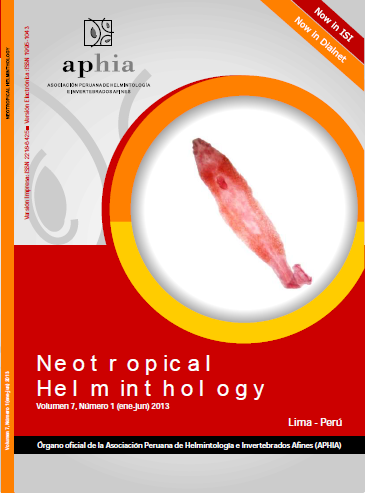PARASITOLOGICAL INDICES OF PACIFIC POMFRET BRAMA JAPONICA HILGENDORF, 1878 (OSTEICHTHYES, BRAMIDAE) ACQUIRED AT THE FISHING TERMINAL OF CHORRILLOS LIMA, PERU
DOI:
https://doi.org/10.24039/rnh201371954Keywords:
aggregate distribution, Dispersion index, gill selectivity, Hatschekia, Hepatoxylon.Abstract
Pacific Pomfret Brama japonica Hilgendorf, 1878 is a migratory pelagic fish of Pacific Ocean. Between August and September 2011, 51 specimens of B. japonica were obtained in Fishing Terminal of Chorrillos, Lima, Peru for the evaluation of: (1) ecological indices of the parasite components of the metazoan fauna of B. japonica, and 2) aggregation and selectivity of ectoparasites and endoparasites most prevalent in B. japonica. The parasites were collected and counted using standard protocols. The ectoparasitic copepod Hatschekia conifera Yamaguti, 1939 had the highest P (prevalence), MI (Medium Intensity), ANA (Abundance Numeric Average) and IEN (Specific Importance Numerical). The endoparasite Hepatoxylon trichiuri (Holten,1802) Dollfus, 1942 presented the highest values of VAA (volumetric average abundance) and VEI (Volumetric specific importance). In H. conifera, H. trichiuri and Koellikeria filicollis (Rudolphi, 1819) Cobbold, 1860, dispersion indices showed an aggregate distribution. Gill sections demonstrated that H. conifera with Dispersion Index (ID) and the Morisita index (I ) showing M greater aggregation in the medial section. ANA of H. conifera showed preference to II, I and III gill arches and medial section. In H. trichiuri, aggregation distribution for ID and IM by location showed that 70% was aggregated and 30% was uniform. Mostly selectivity was observed on H. trichiuri in mesentery, intestine, oropharyngeal cavity and operculum. The total length and weight of B. japonica showed no correlation with parasitological indices of H. conifera, H. trichiuri and K. filicollis. There was only an association between ANA of H. conifera and sex of B. japonica. The K (relative condition factor) was not found associated with the abundance of any of the more n prevalent parasites. A positive relationship was only seen between Gonadosomatic Index (GSI) and H. conifera. In the case of Component community, noted parasites had high values of dominance according to Simpson and Berger-Parker, and low rates of homogeneity by Shannon, Brillouin and Evenness. The Chao-1 values showed that the community is required to increase the sample size. There was an association between H. conifera versus H. trichiuri and between K. filicollis and Contracaecum sp.
Downloads
Published
How to Cite
Issue
Section
License
Copyright (c) 2021 Neotropical Helminthology

This work is licensed under a Creative Commons Attribution-NonCommercial-NoDerivatives 4.0 International License.
OBJETO: El AUTOR-CEDENTE transfiere de manera TOTAL Y SIN LIMITACIÓN alguna al CESIONARIO los derechos patrimoniales que le corresponden sobre la (s) obra(s) tituladas: xxxxxxxxxxxxxxxx, por el tiempo que establezca la ley internacional. En virtud de lo anterior, se entiende que el CESIONARIO adquiere el derecho de reproducción en todas sus modalidades, incluso para inclusión audiovisual; el derecho de transformación o adaptación, comunicación pública, traducción, distribución y, en general, cualquier tipo de explotación que de las obras se pueda realizar por cualquier medio conocido o por conocer en el territorio nacional o internacional.
REMUNERACIÓN: La cesión de los derechos patrimoniales de autor que mediante este contrato se hace será a título gratuito.
CONDICIONES Y LEGITIMIDAD DE LOS DERECHOS: El AUTOR-CEDENTE garantiza que es propietario integral de los derechos de explotación de la(s) obra(s) y en consecuencia garantiza que puede contratar y transferir los derechos aquí cedidos sin ningún tipo de limitación por no tener ningún tipo de gravamen, limitación o disposición. En todo caso, responderá por cualquier reclamo que en materia de derecho de autor se pueda presentar, exonerando de cualquier responsabilidad al CESIONARIO.
LICENCIA DE ACCESO ABIERTO: El AUTOR-CEDENTE autoriza que manuscrito publicado en La Revista Neotropical Helminthology permanece disponible para su consulta pública en el sitio web https://www.neotropicalhelminthology.com/ y en los diferentes sistemas de indexación y bases de datos en las que la revista tiene visibilidad, bajo la licencia Creative Commons, en la modalidad Reconocimiento-No comercial- Sin Trabajos derivados –aprobada en Perú, y por lo tanto son de acceso abierto. De ahí que los autores dan, sin derecho a retribución económica, a la Asociación Peruana de Helmintología e Invertebrados Afines (APHIA), los derechos de autor para la edición y reproducción a través de diferentes medios de difusión.


 Numero 2 Volumen 19 - 2025 (versión Anticipada)
Numero 2 Volumen 19 - 2025 (versión Anticipada)














































